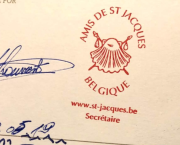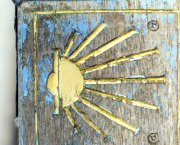
Deleted
 9 min
9 min
Deleted

Photograph of detail on a public interpretation panel. Photo: C. Mansfield 30.6.2014.
A Novel from Travel Journaling
Marcel Proust was born just weeks after the Paris Commune in the summer of 1871. His life reaches into the twentieth century and through the First World War. Born into one of the successful bourgeois families that emerged from the revolutions in France, his documented life and his own novels present readers with a leisured social class in which a young man could choose to become a writer. His narrating character in his major novel, À la Recherche du temps perdu (published over the period 1913-1927), is called the young Marcel, and with Proust's declared intent to scientifically investigate personal memory, the volumes of À la Recherche hover between fiction and autobiography. Actual key figures from the time are mentioned in his novel, for example, Viollet-le-Duc, renovator of Notre-Dame cathedral. This further connects the narrative with the real history of this era. While Proust's critical writing challenges nineteenth-century literary criticism's biographical emphasis, which was the legacy of Charles Sainte-Beuve, Proust's fiction explores the biographical details of becoming an author.
Proust's own family life meant that he could enjoy the long summer holidays of the bourgeoisie in the seaside resorts of Normandy and Brittany where farms were being converted to hotels and new villas were springing up to accommodate the families and servants of the educated technical professionals.
White Sands
During my slow residency in Concarneau, I learnt that Proust had begun his first novel across the bay, in Beg Meil. I wondered if my author, Georges Simenon had known this literary link when he chose to over-winter in Concarneau in 1930. As the famous Trussel site tells us:
‘During November and December 1930, Simenon rented part of the villa "Ker-Jean", 11-15 Avenue des Sables-Blancs, northward along the coast from Concarneau (Finistère) in Brittany. Here he wrote the Maigret novel "Le Pendu de Saint-Pholien" (The Crime of Inspector Maigret).’ Quoted from the famous Trussel Maigret resource.
Le pays de Fouesnant
I arrived in Beg Meil on 11th April 2013 and checked-in to the Hôtel de la Cale. The cale is a wedge-shaped slipway into the sea. From the cale, I looked across Forest Bay and could make out the fortified walls enclosing Concarneau’s Ville-Close island. The manager, and I suspect, the owner of the hotel did everything. She showed me to my room, prepared a late lunch, served it in the quiet restaurant, and then she went to open the bar. I began to talk with her to try to find any points of reference for Proust’s sojourn in Beg-Meil. Unusually, she did know of the literary link; as other literary tourism researchers know, locals have often never heard of the author you are investigating. She produced an iPad from behind the bar and found the PDF of an article she knew well.

My photograph shows the view from my window in the Hôtel de la Cale down through the sunken lane to the slipway. Across the bay you can just make out the line of buildings of Concarneau. The large white building was until 1973, the Hôtel Fremont Photo: C. Mansfield, 11 April 2013.
It was a wonderful piece of well-researched but readable writing. The author drew on Proust’s letters to his friends, quotes from the novel, and made use of old post cards. All the practices of a literary travel writer. The piece ends with a facsimile of Proust’s signature in a local hotel register. What more could you wish for? The perfect indexical trace that your author had stayed here. Only later, like Minerva’s owl, did I realise that I was reading a type of text that I would later call literary travel writing. Even though the author, Jean Le Foll, had not used the first-person I-narrator, all the other ingredients were there to create a catalyst for the visitor. It was also a vade-mecum in that, with a little help from the hotel manager, it gave me buildings to look for and identify in this small hamlet.
Proust on Holiday
Jean Le Foll (Le Foll 1995) places Proust on holiday on Concarneau Bay in September 1895 by using Proust's correspondence and his incomplete and fragmentary novel Jean Santeuil. The novel was probably started around that same time, as Le Foll notices that Proust mentions the poor quality writing paper available at the hotel. A French version of Jean Santeuil appears long after Proust's death, in 1952 and Gerard Hopkins translated an edition into English in 1955 (this is still available in Penguin, referenced here as, (Proust 1985). The novel opens with these lines helping situate the action and giving insight, if like me, and Le Foll, you use literary fiction as a source of data, into tourism in Brittany in the mid-1890s:
'I had gone to spend the month of September with a friend at Kerengrimen, which in those days (1895) was a farm tucked away among apple orchards on the Bay of Concarneau, miles from any village. A great many Parisians and English people were in the habit of going there for the summer and using the house as an hotel. But the owner old Père Buzaret still called it a farm, and was at pains to see that it should look like one'. (Proust 1985, 3).
Reading on the Beach
In passing, too, the farmer was already concerned with staged authenticity in his endeavour to retain the rustic charm of the rural setting. Through literary detective work we learn that Marcel Proust then moves on. In a letter to his friend back in Paris, Proust heads the notepaper in good journaling practice, Hôtel Fermont, Beg-Meil, Finistère, September 1895. Beg-Meil means the Mill on the Headland in Breton, something like Millpoint. Le Foll has identified this location today. He explains that it is the Grand Hotel (Le Foll 1995), with a view over the bay to Concarneau. Indeed in his unfinished novel, Proust returns to describe this view, with the Glénan Islands (Proust 1985), the grey stone Norman church and in the distance, reflected in the waters of the calm bay, 'the lovely fourteenth-century ramparts' (Proust 1985, 375) of Concarneau itself. Proust's character, Jean, begins to provide future holiday-makers with a list of acceptable activities to pursue at the seaside. For example, the next section of the novel is called 'Reading on the Beach' (Proust 1985, 376), and the Beg-Meil section is rounded off with a philosophical speculation on the relation between beautiful prose and the place where it is enjoyed:
‘It seems that the beauty of art can grow roots, can by degrees become part and parcel of the place it inhabits, a thing unique, something that we can never experience again unless we return to that one spot where first it came to us’ (Proust 1985, 375).

My attempt to capture the terrace of Yves Fremont's Grand Hôtel as an old postcard image. Photo: C. Mansfield, 11 April 2013.
It explains, too, what tourists with a whole season ahead of them were seeking to experience. Nouvelles Frontières TUI now operate a large resort in Proust's Beg-Meil through its Club Vacances brand, with half- and full-board offerings in a newly-built complex of 24 apartments, 108 bungalows and 46 caravans (Nouvelles Frontières 2012). And the area, never shy of tourism, has rebranded itself as #rivierabretonne for a new generation of holidaymakers.









 English
English
 Français
Français
 Deutsch
Deutsch
 Italiano
Italiano
 Español
Español



 Contribuisci
Contribuisci








 Puoi sostenere i tuoi scrittori preferiti
Puoi sostenere i tuoi scrittori preferiti






Alexia Monrouzeau 3 anni fa
22/10/2022, 8:17:
Though I can't stand reading Proust (I tried this summer again, no way for the moment), I've been through your article, and that's my little miracle, not that bad for a morning...thank you.
Charles Mansfield 3 anni fa
Thank you for reading through to the end, Alexia - Charlie